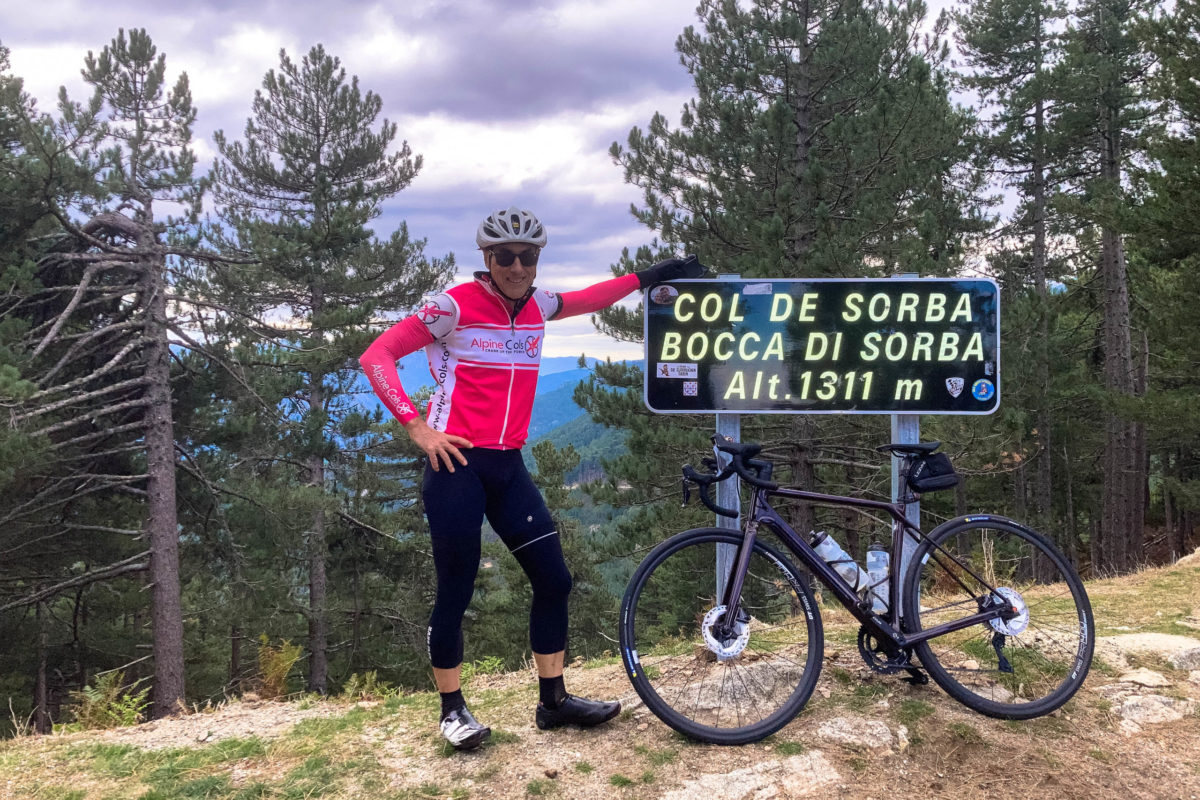
I first found out about the Cent Cols Challenge events in January 2020, when I read an article in Vélo Magazine. The challenge is to climb one hundred cols, over ten stages, with each stage around 180-200 km long and including from 3,000 to over 5,000m of climbing. You can thus expect to ride close to 2,000 km and climb as much or more than 40,000m in ten days. If you know cycling you know this is extreme, crazy stuff. Every day is right on the upper limit of what is possible to ride in daylight and sleep in a pre-planned hotel at night. To put it in context, it’s comparable to riding the Marmotte ten times on ten successive days. Mercifully, there is a rest day in the middle, and it is not a race.
So what on earth made me sign up for this? I don’t really have a good answer, other than that I find it hard to resist a cycling challenge, I have long wanted to explore Corsica, the dates were convenient and, above all, after training for two years for the Tour du Mont Blanc I was as fit as I’m ever likely to be, so it was now or never.
In the account which follows I have tried to capture the essence of riding a Cent Cols Challenge as well as the special experience of cycling the first five stages in Corsica. I’ll follow it up with an account of the last five stages and then a separate analysis of my rides from a coach’s viewpoint.
Getting there
I live near Geneva. Normally getting to Bastia is easy, via a daily direct flight with easyJet. Thanks to Covid-19 these have been cancelled so I was forced to go through Lyon, from where the only flight would get me there at 3pm on the eve of Stage 1. A bit risky, but I had little choice: I couldn’t afford the extra time of getting there several days in advance. Seated in the aircraft as we pushed back, dead on time, I was sure I had made a good decision.
A few minutes later, we were rolling down the runway at 200km/h on the point of take-off. There was a sudden loud bang as we hit something. The plane shook alarmingly as the pilot immediately threw the engines into reverse, we were thrown forward in our seats and I had visions of the end of the runway approaching fast as we shuddered to a stop. My first thought was: damn, that’s probably screwed things for Stage 1: my challenge is over before it has even begun…
It turned out that we’d taken a bird strike in the port engine. After an anxious two hours wait back in the lounge the plane was declared safe to fly, so with much relief we re-embarked and finally landed in Bastia three hours late.
The only real consequence was that I missed the introductions and the briefing (although of course Phil went over the important parts with me privately). The moral of the story is: always plan to arrive at least one day in advance…
It’s awkward to join a group after the introductions have already been made. Everybody knew my name, while I knew nothing about anybody when I entered the room. Phil was in full flow and in these times of Covid it didn’t seem appropriate to go around the table shaking hands with everyone, so I smiled, waved and sat down at an empty space. As I looked around the table, Phil, who was standing up, was as you’d expect, slim, wiry, not an ounce of fat, looking every inch the experienced endurance cyclist. The remainder of the group looked unexpectedly diverse, ranging from immediately recognisable climbers to people who looked better suited to Paris-Roubaix than to the mountains.
I was to find out later that the group of thirteen included eight different nationalities and a wide variety of professions. There was one woman. More than half had ridden previous Cent Cols Challenges – with varying degrees of success – and already knew each other. Three in particular had been unable to complete their previous attempts and were determined to learn from their mistakes and succeed this time round.
Stage 1 Bastia to Corte: 190km 4,150m
The alarm went off at 6am. Breakfast was at 6.30, luggage to the van and day bag to the car by 7.15 and we started riding at 7.26, destination Corte via the high road. This first day was to set the pattern for all those to come: up, down, up, down, up, down… No sooner did we finish a descent but the next climb began.
 Stage 1 profile
Stage 1 profile
First up was the col de Teghime (536m). We all rode it too fast (of course); consciously or unconsciously, the stronger riders were keen to establish the hierarchy while nobody else wanted to be left behind. We regrouped on top by the war memorial to the Franco-Moroccan troops who died liberating the island in 1944. We were soon enjoying our first sweeping descent, with stunning views across to the western coast. Before long, I was to run out of superlatives to describe the views: it’s not for nothing the French call Corsica l’ìle de beauté (the island of beauty).
Later in the ride we had our first taste of the maquis, the vegetation so characteristic of Corsica. It’s a mixture of low trees and shrubs, especially holm oak, cork oaks, juniper, myrtle, strawberry trees, heather, rosemary, thyme, fennel and numerous other ligneous and aromatic plants that thrive in the Mediterranean climate. It’s often very dense and impenetrable, except by the numerous pigs, both wild and domesticated, that roam over the island.
I could hear pigs grunting and snuffling in the undergrowth as I rode by, and there were many signs of them rooting by the side of the road. I didn’t see them this time but later they were to become a common sight. Mostly, the only sounds I heard were of my own making: my breathing, the rumble of my tyres, the wind in my ears and either the gentle whirring of my chain or the frenetic clicking of my free-wheel hub in a descent.
The climb to the col de Bigorno (885m) turned out to be on a very narrow, single track road with a poor surface, lined by bright green ferns and chestnut trees pregnant with fruit. Nets were spread under some of the trees to catch the ripening chestnuts, and in places we had to ride carefully to avoid the nuts lying on the road. Further up, there were groves of olive trees with the nets still rolled up. It was very windswept and quite cold on the col: a warning of things to come.
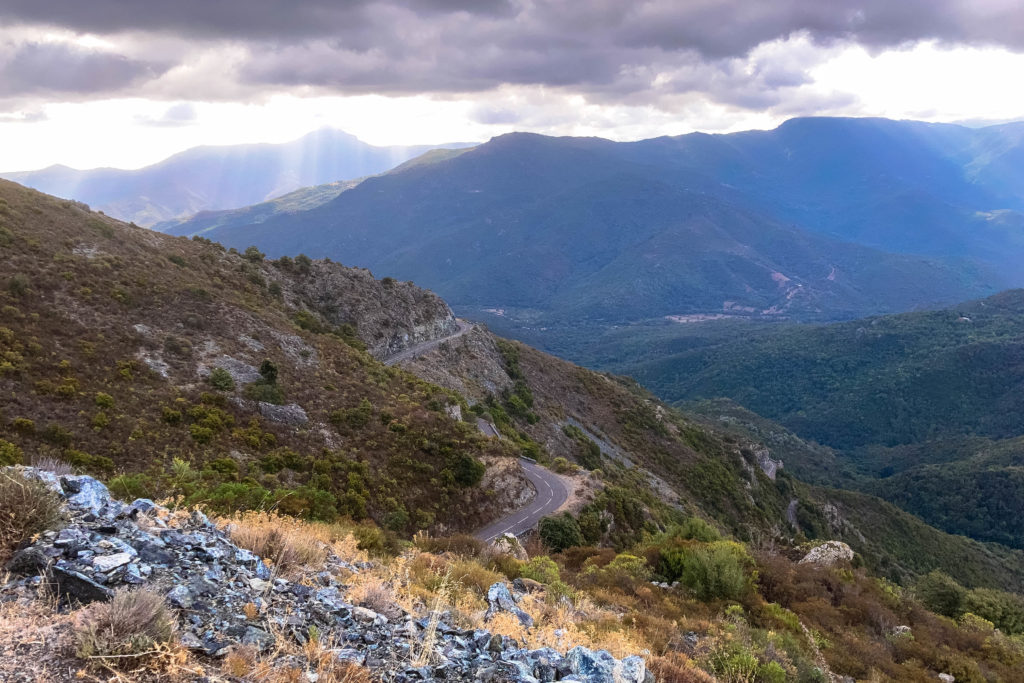 The descent from the col de Bigorno
The descent from the col de Bigorno
The first feed stop was in Campile. Throughout the ten days I was to eagerly anticipate our feed stops, where the ever-smiling Eric served us with copious amounts of delicious food. My favourite at the first stop was always the muesli, which Phil soaked overnight in rice milk and improved with extra seeds and fruit. I usually couldn’t resist two bowls, before filling my pockets with Belgian honey waffles, oat bars and other delicacies to eat while riding. I was burning from 5,000 to 6,000 extra calories per day, so failure to eat enough would soon have had serious consequences.
We passed through or near numerous remote mountain top villages with names redolent of Corsican culture and history: Canavaggia, Bisinchi, Petricchicchia, Crocicchia, Casabianca, Polveroso, Verdèse, Pietricaggio, Pian di Fossé, Sourceorezza, to name just a few. Most of these villages would have no more than a hundred inhabitants. They were all picturesque, Instagram-ready, each with its own church and spire, the houses all traditional, made of granite, blending into the landscape as they had for centuries past. I could have stopped a thousand times on every ride to take photographs.
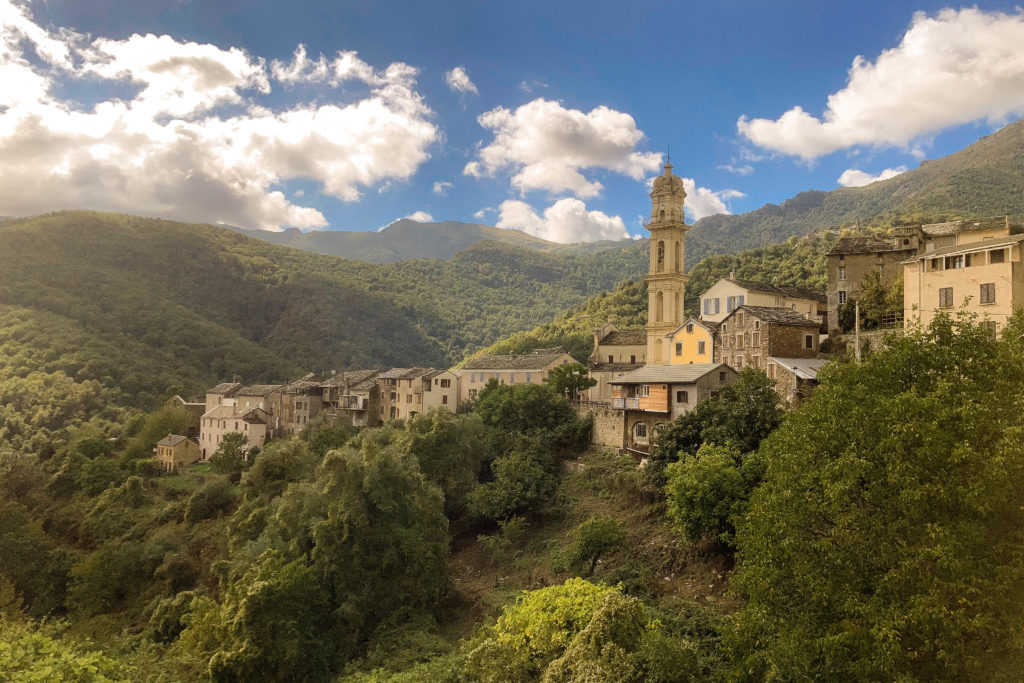 The village of Verdèse (pop. 36)
The village of Verdèse (pop. 36)
In general the roads were good, but the descent after Croce was in shocking condition, with big holes, broken surface, gravel and mud. As I hit this section, I was shaken around so hard I could hardly reach the brakes to slow down, and desperately looked ahead to pick my best route through what looked like a bomb site. Not for the first time (nor the last), I was glad to have a new bike with wide, low pressure tubeless tyres and disk brakes.
Sometimes I rode for a while with one or other of my companions, but mostly I rode alone. This wasn’t deliberate, it just happened that way. Other riders were never far away, but each of us preferred to stick to our own pace, stop when we wanted to and generally not feel constrained by the need to adapt to someone else. At different times each day I would ride a few hundred metres or more with different people, and we would often overtake each other or be overtaken. The group as a whole was rarely spread out by more than a few minutes between the first and the last.
Here on the eastern side of the island’s mountainous spine we cycled through what seemed like a temperate rain forest, with an impressive variety of lush vegetation. The trees were weighed down with lichens, lianas and creepers of all sorts and hues of green, the air was humid and the road was damp. Sometimes the trees formed a complete tunnel, cutting off the light and creating the impression of being underwater in a kelp forest. I almost expected to see a fish swim by.
We saw more and more livestock as the ride went on, with numerous pigs, cows, sheep and goats encountered, often on the road itself. The smell usually gave me a few seconds warning as I approached a pig farm, but there’s no warning at all when the animals are on the road. Steep, wooded descents must be taken with due care and attention!
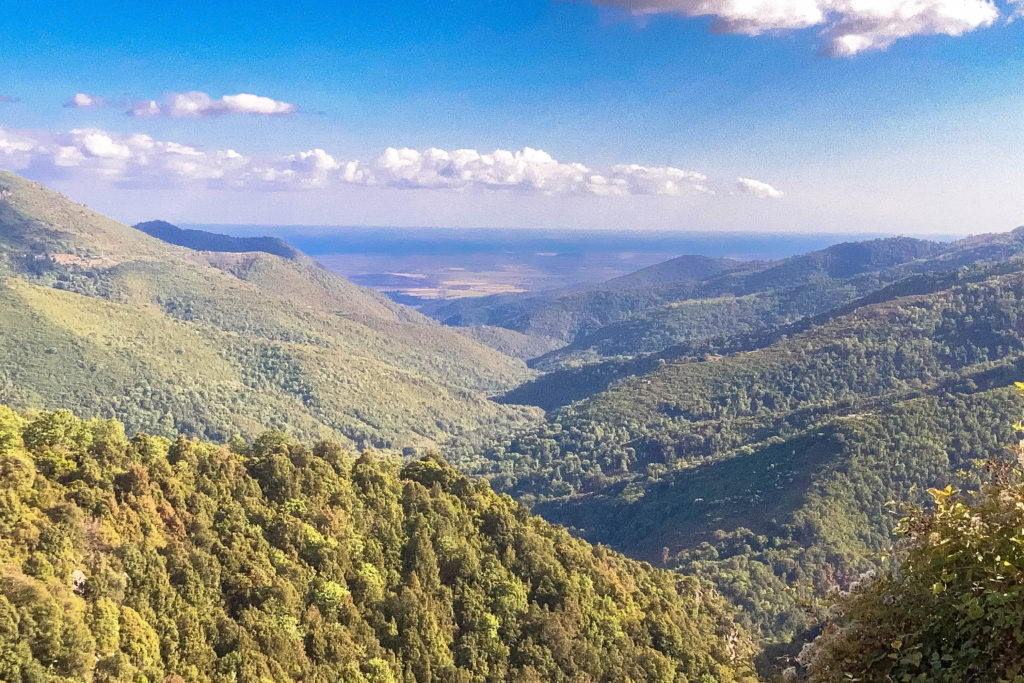 View SE from near Matra
View SE from near Matra
You can have too much of a good thing. It was a wonderful ride, but night was falling and it was getting cold when we arrived in Corte, 10 hours and 35 minutes after leaving Bastia. It was a relief to see our hotel and I wasted no time in claiming my room. The hotel was a rather down-at-heel two-star built in the 1930’s, but it had one saving grace: the showers were excellent and hot water was plentiful. I was stripped off and standing under it in seconds, soon feeling my tired muscles relaxing deliciously under the warm flow.
Stage 2 Loop around Corte: 192km 4,450m
Corte is right in the centre of the island at an altitude of 450 m and surrounded by mountains. It only gets the sun for a few hours around noon, so no surprise that it was cold and still quite dark when we started at 07:30. I wore knee-warmers, arm-warmers and an insulated gilet and still felt quite cold for the first half an hour or so. My legs were as stiff as boards when I got up and tried to walk down the stairs, but loosened up surprisingly quickly once on the bike.
 Stage 2 profile
Stage 2 profile
Our route today began with a loop to the north-east of Corte, then went up the Gorges d’Asco to the highest point of the Challenge at 1,420m and finished with another there-and-back climb up the Gorges de la Restonica.
The first part was on a beautiful quiet road. The sun was now up and picking out the mountain tops and distant villages on rocky outcrops, and there were beautiful views across to the eastern coast, where we could see the sea. The vegetation here was quite unusual, with only very low scrub and heather leaving the hillsides looking bare.
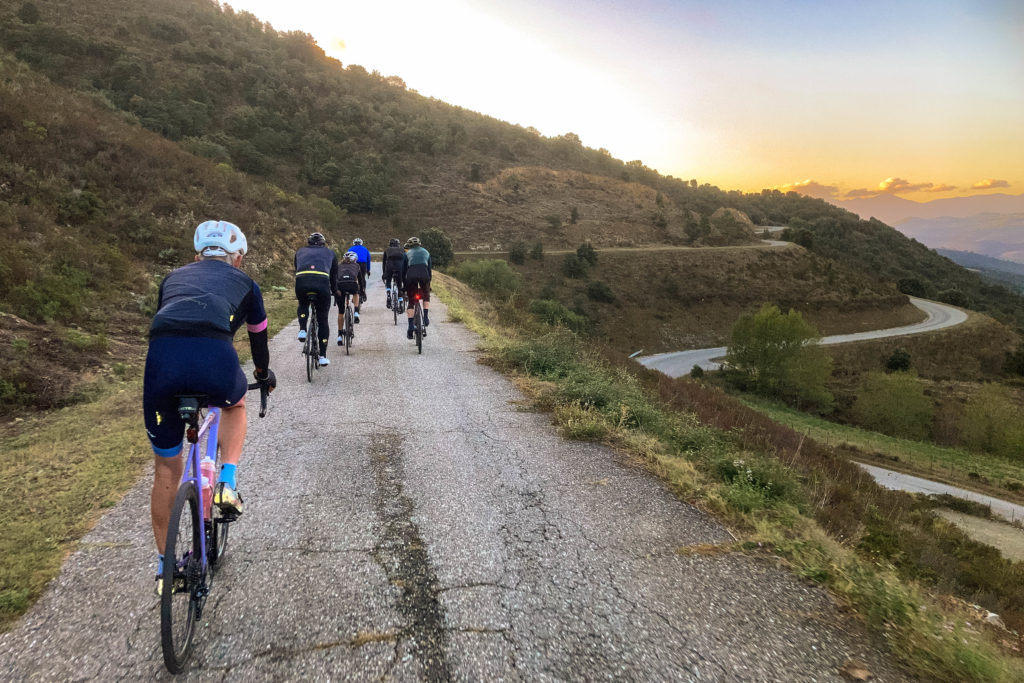 8am, on the climb to Tralonca
8am, on the climb to Tralonca
It was Sunday so the local hunters were out, stationed every few hundred metres along the road, dressed in a curious mixture of camouflage kit and hi-vis jackets, guns at the ready. They were yodelling to each other across the valley, their dogs barking excitedly somewhere in the dense maquis below. A shot rang out.
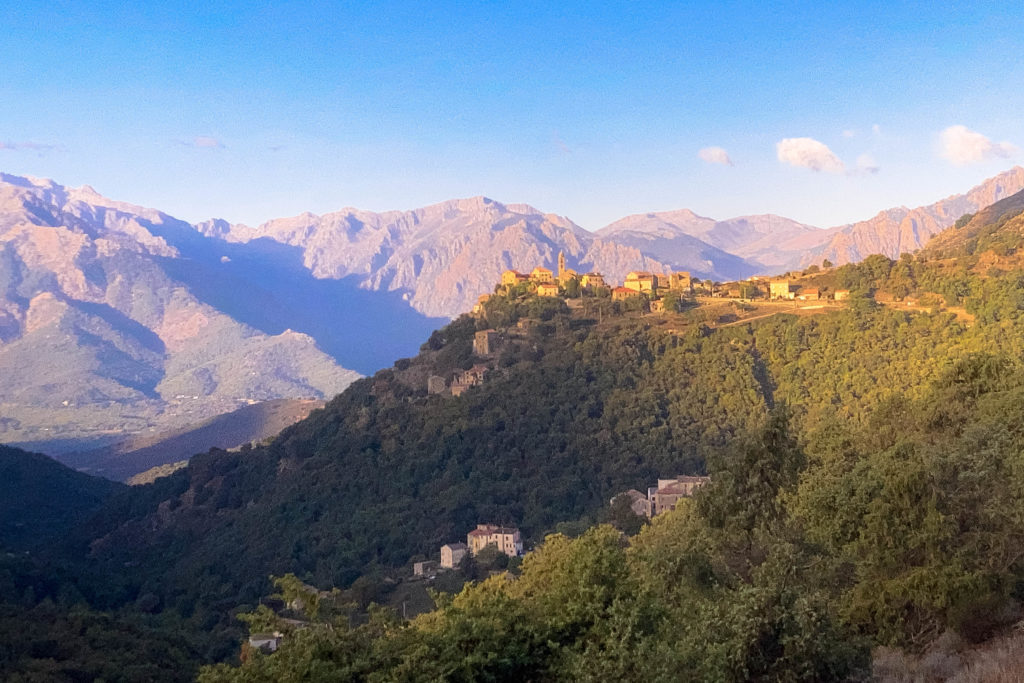 Santa Lucia di Mercurio
Santa Lucia di Mercurio
We passed through Bustanico, a village with very narrow streets full of people out for a Sunday stroll. A friendly dog greeted me and I exchanged cheery “bonjours” with the owners.
At the exit of the village I took the obvious road, but my Garmin soon beeped a warning: Off Course. This was a common occurrence until I stopped guessing the route and consulted the Garmin before every intersection.
It was a steep climb out of the village, the gradient up to 12% for a few hundred metres. A donkey brayed and more dogs barked. There was a marked change after the col, where we descended through a thick deciduous forest in deep shadow. The temperature immediately dropped to 6°C and it felt very cold and gloomy. I was thinking about this and wishing I had long-fingered gloves when a dark brown cow in the middle of the road loomed suddenly out of the shadows, requiring quick evasive action. Ooops!
Another climb brought us to the village of Morosaglia, from where we enjoyed one of the best descents I’ve ever done, a series of easy, flowing bends down to Ponte Leccia. We weren’t the only ones to appreciate this road: every bend had heavy black tyre marks from a vintage car rally that took place a few days previously.
The first feed station of the day was by the railway station in Ponte Leccia. It was warm in the sunshine and nice to take off my knee-warmers.
I knew there were 8km of flat and false flat to the start of the next climb and shamelessly timed my departure to get a free tow from the two fast guys. An occasional threshold effort was well worth it to avoid a long solo slog!
We headed up the Gorges d’Asco, our destination being the ski station at the end of the highest road on the island. The scenery up the gorge is quite simply amazing, the rock formations stunning in their grandeur. The road follows the river as it twists and turns through the gorge it has made, the water clear and sparkling as it jumps and splashes over the rocky riverbed. Every twist and turn in the road demanded a new photograph.
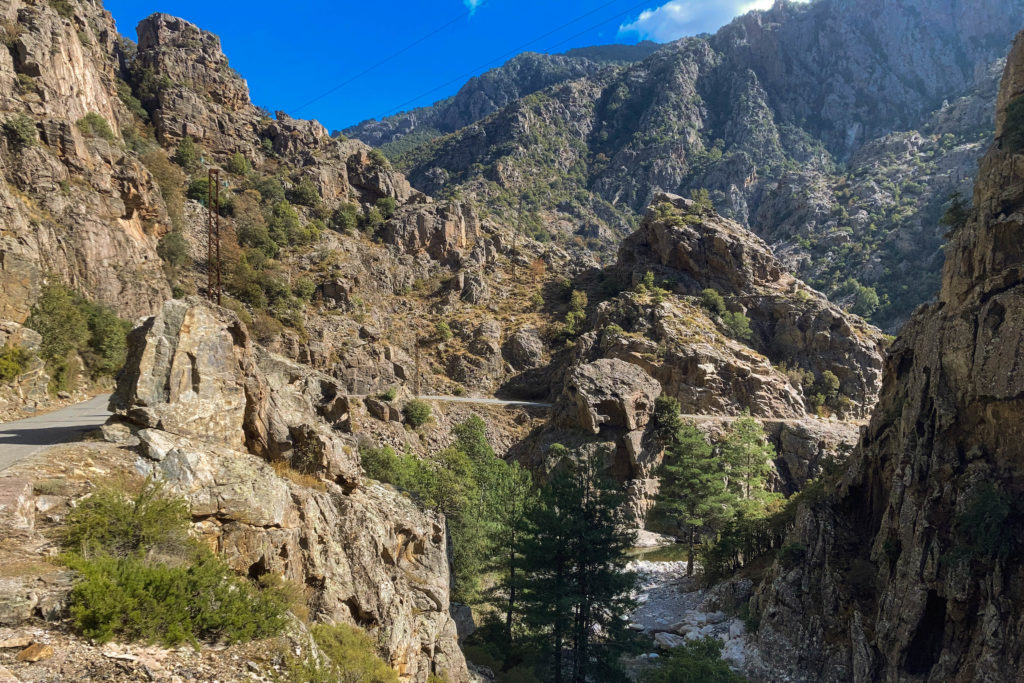 The Gorges d’Asco
The Gorges d’Asco
The road is a fairly gentle climb until the village of Asco, but afterwards becomes very irregular, alternating steep pitches with flat sections and even descents. I am not sure I have ever used the front derailleur so much on a climb. The sun was now high and we stripped down to minimum summer kit as the climb got hotter and harder. The road narrowed and we were forced to weave between piles of droppings left on the road by the local cows.
We arrived at the top after 1h20 to find the café closed, but the ever-resourceful and persuasive Mateusz, the team mechanic, soon convinced them to serve us 12 coffees.
Our senses thus sharpened, we launched into an exhilarating long free-wheeling descent all the way back to Ponte Leccia for lunch.
Quiet side roads took us over two climbs back to Corte, where after 9 hours, 170km and 3,500m we cycled right past our hotel and carried on for one more climb, and not a small one: the Gorges de la Restonica. Another 16km and 910m to climb!
This is a seriously tough climb, especially in the long mid-section where the gradient is over 10% for several kilometres, often reaching a leg-busting 14-15%. It was beautiful – probably as much so as the Gorges d’Asco – but sadly the valley was in deep shadow and getting very cold in spite of my intense efforts so these attractions were rather lost on me.
To succeed in the Cent Cols Challenge you have to ride every metre of the way. I nearly failed here, near the end of Stage 2. The temperature was only 6° at the top, and I arrived wet from sweat and without adequate clothing for the descent. I cannot remember ever being so cold on a bike. I was shaking and shivering, and without long-fingered gloves my hands were frozen and almost unable to operate the brakes. The only thing that saved me was the loan of a jacket by Mateusz. I learned my lesson here: think ahead and be self-sufficient.
The excellent shower back at the hotel was a life-saver. I certainly wasn’t the only one to stay under it for at least 15 minutes. Warm enough at last, compression socks on, I lay back on the bed and did some gentle stretching to speed my recovery.
Stage 3 Corte to Propriano: 196km 4,000m
Third day, another big stage, another early start, this time with a change of hotel so all must be packed and brought down in good time. Forget the boards, my legs were now as stiff as concrete posts and were asking me a serious question: do you really want to do this? I ignored the question and applied my backside very gingerly to the saddle. Even with very liberal use of chamois cream, there was a deep ache that was unlikely to be improved by ten more hours of cycling. It was going to be a long day!
 Stage 3 profile
Stage 3 profile
There were two Tour de France climbs on the menu. This is a rarity in Corsica which has only been visited once by the Tour in 108 editions. Corsica’s big opportunity was in 2013, when after a flat stage 1 from Porto Vecchio to Bastia (remember the farce of the bus stuck under the finish line gantry?) Stage 2 took the riders from Bastia to Ajaccio, over the cols of Bellagranajo, Serra and Vizzavona. These are of course on the main road, but Phil had designed a clever route which allowed us to cross the first two while remaining mostly on quiet side roads and including several other more interesting climbs.
We began with a few kilometres of false flat descent, heading south-east with the rising sun in our eyes. This didn’t last long. We turned off over an ancient stone bridge onto a minor road to the col de Bellagranajo. The road was cut through the rock, stratified schist in all shades of grey, sharp angular planes jutting out, with occasional white intrusions (probably calcite, according to our resident geologist). The maquis smelt strongly of immortelle plants and wild rosemary. The pigs had been active overnight by the side of the road.
The col d’Erbajo (920m) was on a nice wide road through a pine forest with stone parapets, reminding me of the road from Granadilla to Vilaflor in Tenerife. The descent was flowing and rhythmic, a delight to lean the bike from side to side through the bends, pushing down hard and twisting it to accentuate the grip.
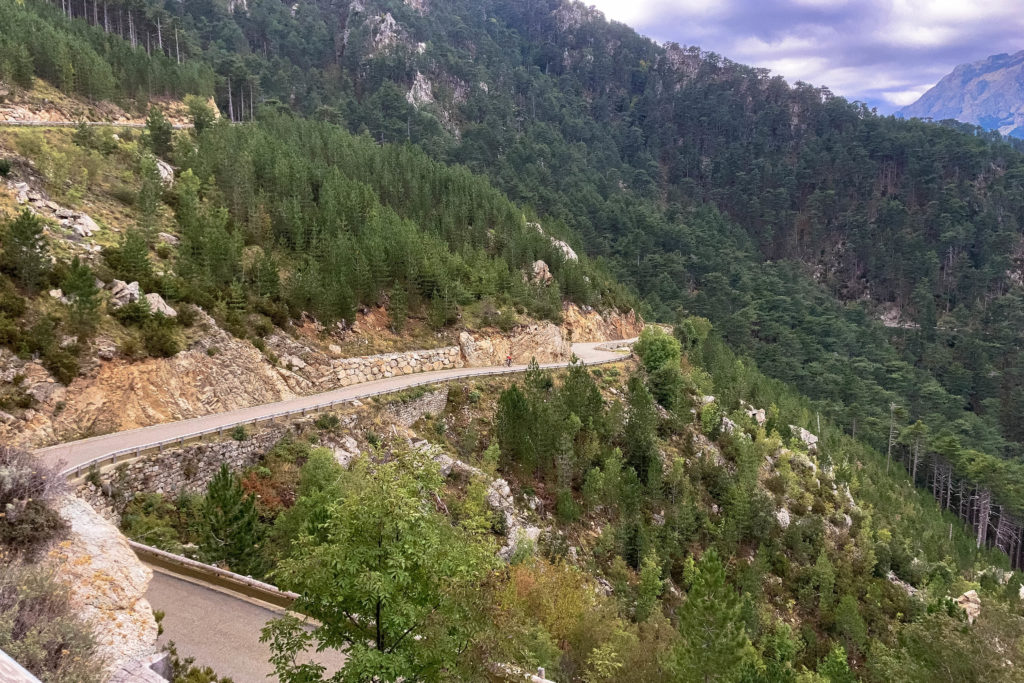 Col de Sorba
Col de Sorba
There was no transition to the col de Sorba (1,311m), and barely time to change gear and drop to the small ring. We hit the bottom and started climbing again immediately, to the smell of wood smoke from the gardens in the village. We were running parallel to but much higher up than the Tour de France route.
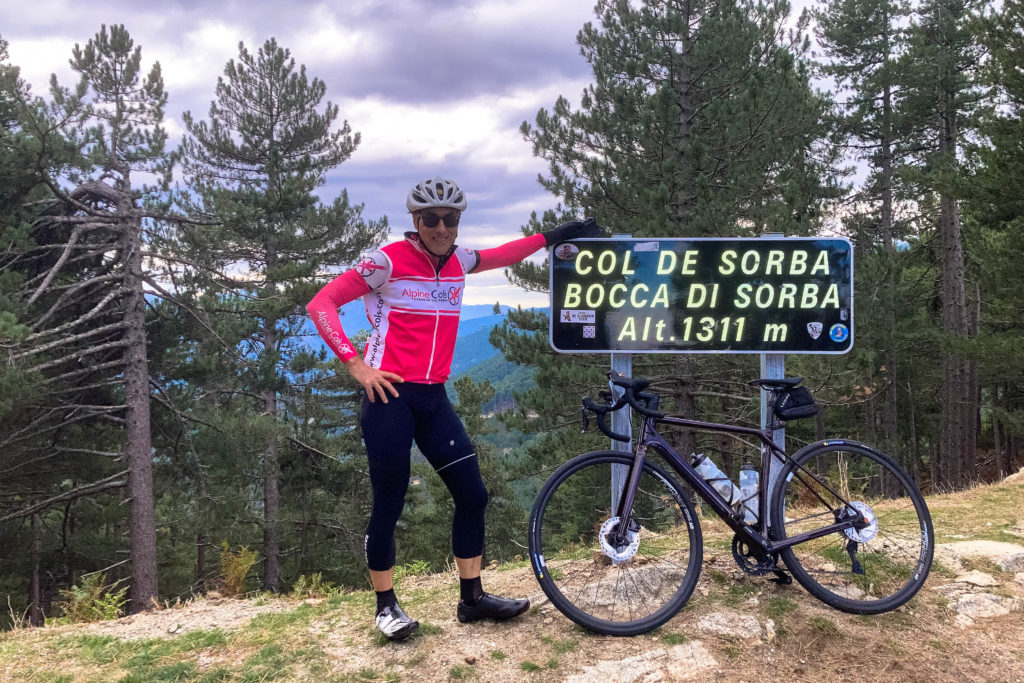
A cold descent and it was time for our second breakfast! The van was parked behind the church in the small village of Ghisoni. We ate quietly as the bell was tolling for a funeral. Incongruously, a friendly Labrador sat down in front of us, stared intently at the food and offered his paw to anyone who would shake it.
There was a cold wind blowing so it took a while to warm up again on the next climb. We were largely in the shade, and the sun was often behind the clouds, so it remained cool all the way to the col de Verde (1,289m) – a long, pleasant climb through pine forest, sadly spoiled by a heavy forestry tractor crawling up the road at 15km/h who took an age to catch and overtake me and then ground on, remaining in earshot until after the summit.
On the col we crossed the spine of the island and the GR20, the famous long-distance hiking trail which runs the length of the island from north to south.
I had one of those “back-to-reality” moments on the descent. I thought I was descending extremely well, overtaking my companions by flowing fast through the corners, concentrating hard, using all my skills to brake as little as possible, pedalling hard in the straights, when one of them came sailing past effortlessly without even pedalling. Well, he probably weighs 20kg more than me…
There were 40km of descending, traversing and descending again until the next climb. The last few km to lunch in Olivese were on three very broken sections of road in appalling condition, inexplicably punctuated by all-too-short beautifully tarmacked sections. It felt like going three rounds in the ring, with minutes of intense battering relieved by seconds of blissful relief. The only thing missing was the wet sponge on my face.
Feeling re-energised after our lunch break we started up the col de la Vaccia (1,195m). This turned out to be a tough climb, on a narrow road with many steep sections. Pigs and piglets were everywhere. Une vrai vacherie, I thought to myself, playing with the French words (Vacherie can be translated as something unpleasant to suffer, or a mean trick played on you…)
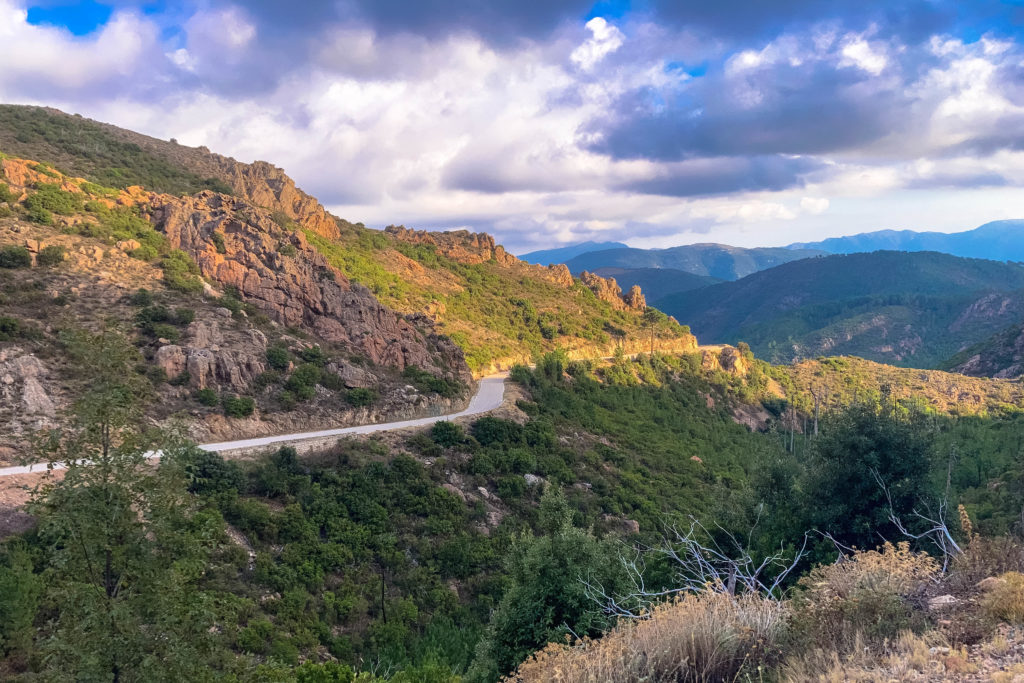 Col de Saint Eustache
Col de Saint Eustache
It wasn’t finished yet. The col de St Eustache (986m) is a very beautiful climb. A serious forest fire in 2009 destroyed all the vegetation and laid bare the rock formations. We followed this with the col de Celaccia and a final fast descent to the sea on a wide main road.
The hotel restaurant had two groups that evening, us and a group of twenty or so pensioners from mainland France, keen to enjoy the full Corsican cultural experience. We were thus subjected first to the off-key singing of local ballads, and then, ô horror of horrors, Corsican polyphonic singing with audience participation. We didn’t linger over the dessert.
Stage 4 Loop around Propriano: 177km 3,860m
If yesterday was bad, today was worse. My legs were very sore and tender to the touch this morning. It was getting harder than ever to use the stairs (there was no lift and my room was on the second floor). It looked like the fourth huge stage in a row was going to be a massive challenge.
It didn’t help that I was slightly slow getting started and left at the back of the group, and was then immediately dropped on the first short rise. There was no way my legs were going to deliver power on demand before warming up. Worse was to follow, with a nasty little kicker to get over, and all but one of my companions disappeared up the road.
 Stage 4 profile
Stage 4 profile
The first proper climb, to the col de Gradella (529m), was a good steady climb at 4-5%. After a few kilometres to my considerable surprise and pleasure my legs were responding well and I started to catch up on the group, even overtaking some.
After an hour and a half we reached Sartène, said to be the “most Corsican” of all the towns in Corsica. Built in the early sixteenth century on a high rocky promontory to defend against the Barbary pirates, the town retains its timeless character with narrow alleys and many high buildings built solidly in granite, looking as if they had been hewn from the rock itself.
I made a navigation error and was concentrating so much on the route that I missed the group sitting at a café. Well, it was a bit early for a coffee stop!
I pedalled on alone, unaware that I was now out in front, turning onto an unlikely looking side road (after another navigation error) and going down a gentle descent. I crossed a stream over a bridge, went past several cows on the road and crossed another bridge, covered in mud, manure and more cows. The road went sharp left, while a narrow concrete track went forward over some gravel and then straight up. There was a no-entry sign. I followed the road.
A minute later my Garmin was more and more insistent that I was off course. Really? I checked and double-checked, but yes, the route went up the steep concrete track, past the no-entry sign. Could this be a file error? The problem was that following the road seemed to involve a long detour.
Nothing for it. Apparently everybody else had gone up here, so I would have to too. It was a crazy steep climb, 1.2 km long, straight up a ramp at 24%, a slight respite at 10-12%, then a second ramp at 26%. I was unable to pedal seated, even in my lowest gear (34-32) and had to stand up, leaning right over the front wheel, which was lifting off the road. I seriously wondered if I could make it up but didn’t dare risk stopping, so pushed as hard as I could, my heart hammering in my throat, hoping it would end before my legs gave out.
When I checked later, my power meter data showed that I had pushed 500W for 10 seconds and 400W for over a minute. It felt like I had burned my entire box of matches and would have nothing left for the rest of the trip, let alone the day, and indeed my legs ached for a long time afterwards.
After a series of ups and downs and a staircase climb to the col de Bacinu (809m), we were treated to fantastic panoramic views across the gulf of Porto Vecchio. The descent was just as we like them, on a beautiful road surface.
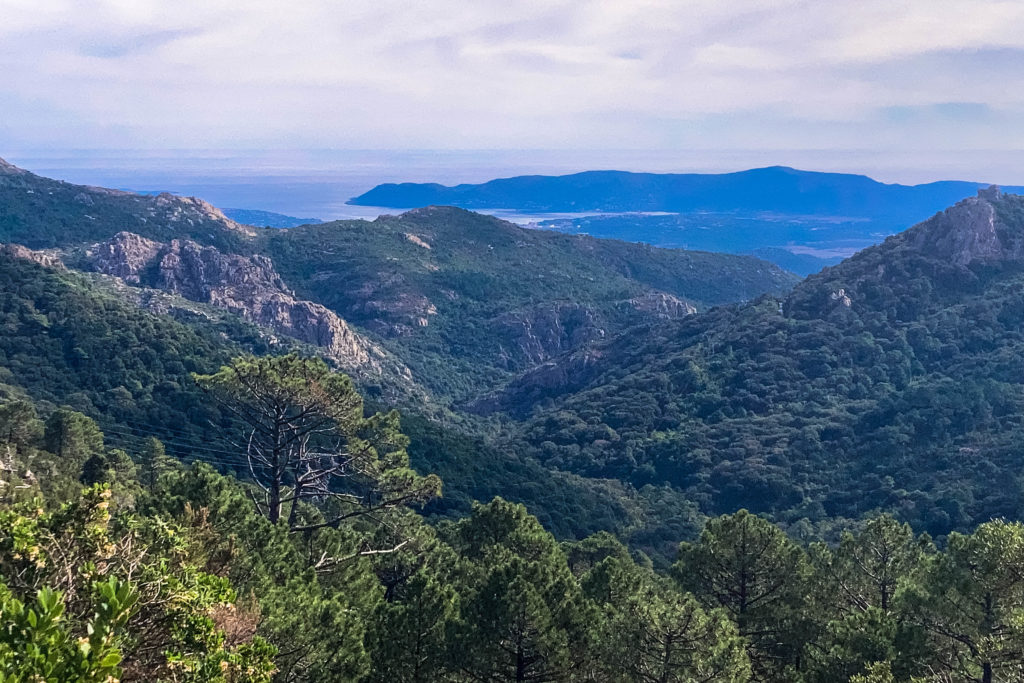 Gulf of Porto Vecchio, from from the col de Bacinu
Gulf of Porto Vecchio, from from the col de Bacinu
We had a 14km flattish section around the outskirts of Porto Vecchio before the next climb. The road was lined with cork oaks, the bottom 2-3 metres of their bark stripped off to expose the russet-brown trunk underneath. We passed numerous second homes and holiday houses with well-cared for gardens, bright with pink bougainvillea, pink or red oleander, yellow mimosa, dark green, pencil-thin cypresses, broad-leaved fig trees, tall pampas grass, spiky ornamental cacti and many other plants, arranged around well-watered grass. It felt very suburban after the wild country we had been through earlier in the day, and hot with it, the temperature at least 10°C higher than on the col.
I have been spending summer holidays near to Porto Vecchio for decades so know the next climb, from Porto Vecchio to l’Ospedale, by heart. I have done it 36 times, but I never get tired of it. It is one of the most beautiful climbs in the world. The road is surfaced with crushed pink granite from a local quarry, giving it a lovely faded pink colour and making it look almost natural.
The gradient varies a little but is never hard as the road winds gently in and out of the ravines and climbs steadily through dense maquis and later through a pine forest. There’s a steeper section through the village of l’Ospedale where there are several inviting cafés, but you really need to finish the climb first! There’s a stunning lookout point after the village, from where you can see Sardinia on a clear day.
There’s a high plateau after the climb, with a lake and fantastic rock formations scattered around a sparse pine forest. Huge granite boulders look like giant children have been playing with them, tossing them around and stacking them at random. The geologist in our party told us, rather dismissively, oh, it’s just weathered granite…
I missed our lunch stop in Lévie. Feeling tired and concentrating on the road I didn’t see it and cycled straight past. There was some yelling behind but I assumed it didn’t concern me and carried on. I was woken up some minutes later by my phone ringing: a kind soul had found my number…
After a short climb to the col de Piattone, another very long descent then a pleasant climb to the col de Siu on a very quiet road with pink granite outcrops turning orange in the glow of the setting sun. The evening light in Corsica has a magical quality, all soft tones of yellow and orange, fading and darkening to indigo and black as the night falls.
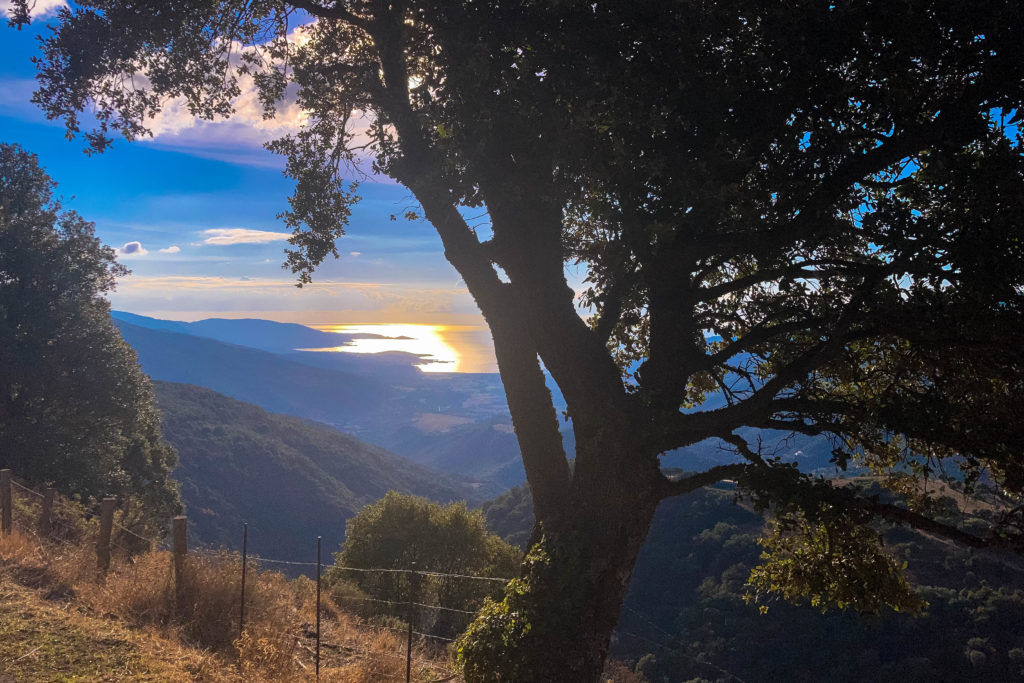 Propriano, from the col de Siu
Propriano, from the col de Siu
The final descent should have been a formality, but was steep, technical and on a very poor road surface. Lucky I don’t have false teeth: I was shaken around on the bike like a rag doll. Thank heavens for disk brakes and fat tyres run at low pressure. Even with these, my hands, arms and shoulders took a terrible beating. Descending this road on 23mm or even 25mm tyres and rim brakes doesn’t bear thinking about, especially after nine and a half hours on the bike.
Thankfully we were the only group in the hotel restaurant that evening and were able to enjoy our dinner in peace. We still didn’t linger over the dessert. Another big day tomorrow, and another change of hotel!
Stage 5 Propriano to Porticcio: 182km 3,820m
One of my companions was concerned about his increasing fatigue and wanted to be sure of finishing in daylight to maximise his recovery. He therefore left half an hour early. This turned out to be very convenient for the rest of us, as after the first five kilometres or so the route sent him up a steep gravel road. He sent a picture to Phil, who confirmed a routing error and said there was no alternative but for him to come back. The timing was perfect for him to re-join the group as we departed, ribbing him gently for the extra distance. It is fair to say he took it very well.
 Stage 5 profile
Stage 5 profile
The Foca di Mela climb was a real staircase of very steep sections interspersed with descents, through thick maquis on a narrow road. This time as we approached a pig farm it wasn’t the smell that announced it, but loud squealing, grunting and jostling as the pigs were being fed, barging each other as they fought for space at the trough.
The staircase continued on a larger scale all the way up to the col de Bavella (1,217m), long climbs interspersed with short descents.
We enjoyed our second breakfast in Zonza, sitting on a stone wall under the plane trees, and I took the opportunity to ask our geologist why the granite was coloured reddish pink. It seems the colour is caused by the presence of potassium feldspar. Now you know.
Sadly the famous Aiguilles de Bavella were obscured by cloud. This much-visited site is a key landmark on the GR20 hiking trail and its majestic spiky towers in red granite are photographed by tens of thousands of tourists bussed up from the coast every summer.
Clouds were gathering ominously on the eastern side of the col, and we had a few spots of rain on the descent. Perhaps distracted by this, I almost fell when I nearly lost my grip hitting a pothole with my hands on the hoods. Always descend with your hands in the drops, kids!
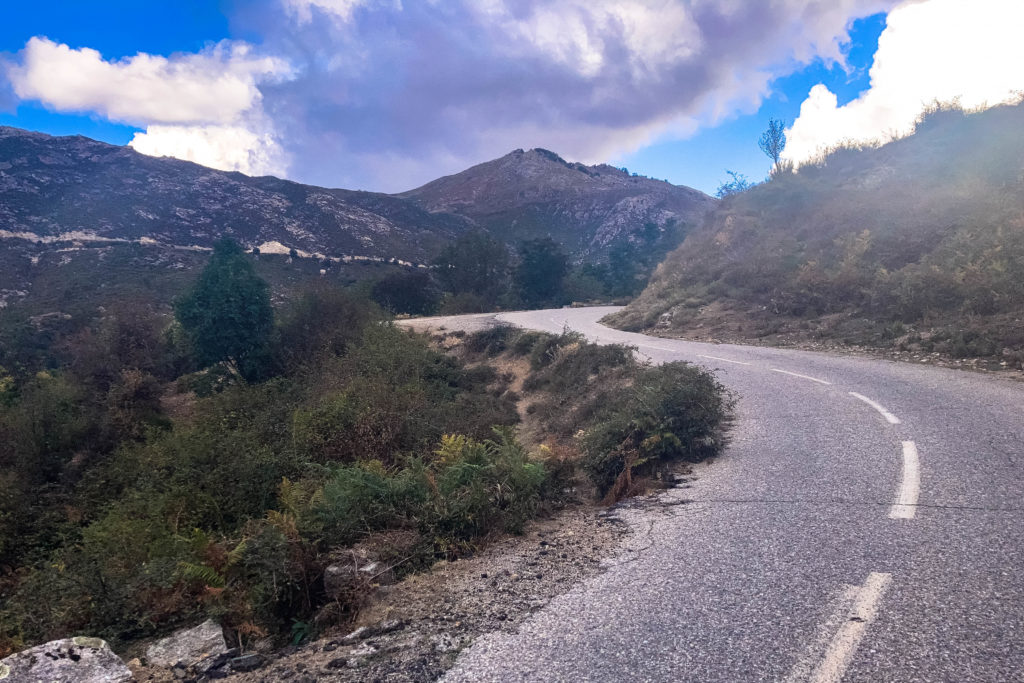 Col de la Vaccia, climbing from the south
Col de la Vaccia, climbing from the south
After a couple more minor climbs we found ourselves back on the col de la Vaccia, which we had crossed in the other direction on Stage 3. From the south it is a big ring climb at 3% until the last 2km. Amazingly, all the stiffness in my legs had disappeared, so I made a decent effort of over half an hour at tempo pace, at one point slaloming around a heavily-pregnant black sow with her teats brushing the ground.
We were still in the sun, but there were more and more menacing black clouds and I soon heard a loud clap of thunder.
The descent to Olivese was also familiar from our climb two days previously. It is a steep single-track road with tight hairpins stacked neatly like bootlaces, making for a technical descent. The road was damp from a recent shower, except under the trees, and there was gravel in places, so I had to be prudent.
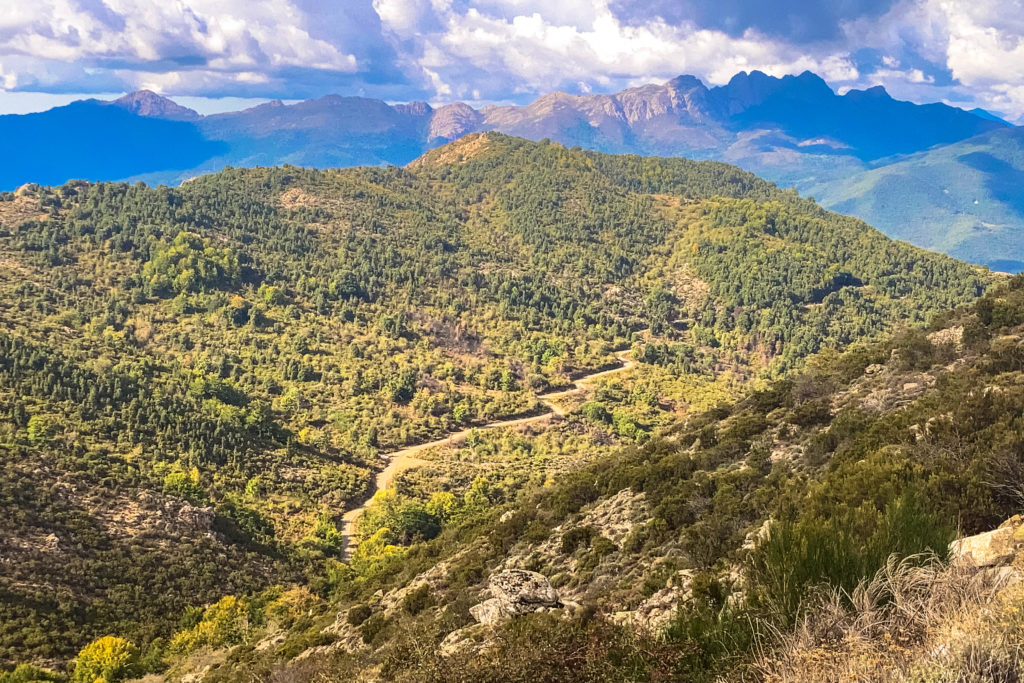 Col de la Vaccia, descending to the north
Col de la Vaccia, descending to the north
We had lunch in Olivese, at the same place as before. It was a convenient shady square, with a water fountain and next to the local café. Looking at the clouds, I checked the weather forecast, which was very positive: all storms moving to the south, nothing expected in the direction of Porticcio. Excellent news! Some sixth sense, however, made me take my rain jacket for the first time in five days.
The rain started about half an hour later and got stronger and stronger, soon becoming a deluge which turned the road into a river. To add insult to injury, it then started hailing heavily. There was soon inch-deep white slush across the road. The hailstones were pea-sized and struck my arms and even my head painfully as they pounded through the slits in the helmet. In spite of this I continued pedalling quite fast, partly to keep warm and partly in the hope that the storm would be localised and I’d soon break out of it. I considered stopping, but soon realised it was too widespread, there was nowhere to shelter and I would have very quickly got extremely cold. There was nothing for it but to keep going.
These last two hours, up to, over and down from the col de Luminatja should have been a delightful ride on quiet roads high up with beautiful views. Under the conditions they became an ordeal. I was wearing a base layer, a jersey and an insulated gilet under my rain jacket, as well as knee warmers, so my core was dry and warm enough, at least while climbing. My legs were warm and wet; my feet and hands were cold and wet. This was no problem as long as I was climbing, but there were about 20km of descent to finish the stage and the temperature was now well below 10°C.
One of my companions, with considerably less body fat then me, was shaking uncontrollably with cold when we came round a corner to find Mateusz with the support car and our day bags. It was a long struggle involving much cursing to pull my long-fingered neoprene gloves on over my wet hands, but once done they were perfect for descending in the rain.
Fortunately, our new hotel had good showers so once again we all spent two or three times longer than normal luxuriating under the flow of warm water.
Dinner was a buffet, noisy and crowded, shared with about 800 retired folks on holiday from the mainland. There was as much food as you could possibly eat, and we duly did.
At the end of Stage 5 we were half-way through the challenge and I for one was badly in need of a rest day. I had ridden 848 km and climbed 20,500m in five days, cycling a little over 9 hrs per day (not including stops). Three of my companions had dropped out completely, and one had been unable to finish Stage 4 and took the day off on Stage 5.
How would my body hold up over another five stages? Only time would tell.
Find out what happened next: Cent Cols Challenge Corsica: the last five stages.
Tempted to ride your own Cent Cols Challenge? Read here my recommendations to give yourself the best chance of succeeding.
About the Cent Cols Challenge
Cent Cols Challenge events are designed and managed by Phil Deeker. There are as many as ten events per year, in regions ranging from the Pyrenees to the Ardennes, from Corsica to the Alps and from the Apennines to the Dolomites. While they vary in difficulty, all are designed to include at least a hundred cols. The difference comes down to the terrain, the quality of the roads and how steep the climbs are, with the weather an ever-present imponderable.
Two superbly written reports, Marvin, with wonderful supporting photos. You’re now in the ranks of Emily Chappell (“Where There’s A Will”) as a great endurance cyclist with writing skills to match.
High praise indeed! Thank you Stuart for the kind words. I’m very glad you enjoyed the read: it makes the writing seem worth the effort!
A quite incredible and absorbing account pushing to the very limits of endurance. Utterly exhausting but what an achievement to finish at all!